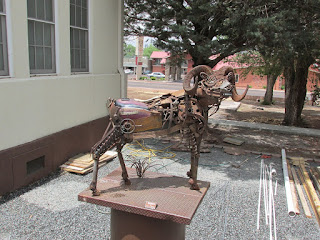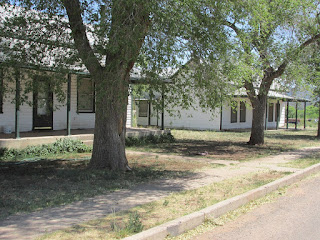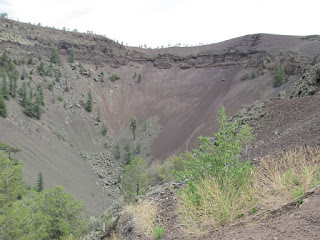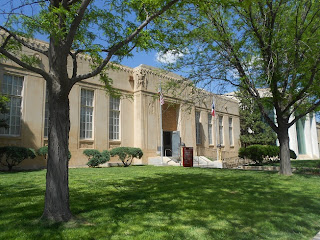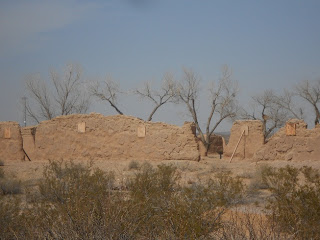Traveling through New Mexico can be a lot of fun if you're looking for historic old military outposts. The history of New Mexico is one of military conquest.
 |
| Ruins of Commanding Officers Quarters |
The Fort Craig Ruins
One very interesting site that Western Trips had the opportunity to visit is old Fort Craig. Today Fort Craig is a National Historic Site which was taken over by the BLM in 1981. The site consists of a Visitors Center and the ruins of the once large and proud military fort. The fort was named in honor of Captain Louis S. Craig who was murdered by deserters in California in 1852.
Fort Craig, established in 1854, was one of the largest and most important frontier forts in the West. Fort Craig had a significant role in both the Indian campaigns in the southwest as well as during the American Civil War. The Fort was home to the Buffalo Soldiers of the 9th Cavalry and 38th and 125th Infantry. The Hispanic New Mexico Volunteers and New Mexico Militia also served at Fort Craig. Fort Craig also saw the presence of Kit Carson who called Taos New Mexico home.
 |
| Ruins of Guard House and Sally Port |
Fort Craig and the Battle of Valverde
To understand the role of Fort Craig you want to know about the Battle of Valverde which did result in a Confederate victory. Colonel. E.R.S. Canby, assisted by a contingent of New Mexico volunteers commanded by Kit Carson, engaged the Confederates at a nearby crossing of the Rio Grande. The Confederate invaders who were referred to as the Confederate Army of New Mexco were led by Brigadier General Henry H. Sibley. An interesting side note is that this is the same Henry H. Sibley who invented the Sibley Stove. If your travels take you to Fort Stockton Texas you can view an authentic Sibley Stove on display at the Fort Stockton Museum.
 |
| Diagram of Battle of Valverde site |
Eventually, Sibley and his forces were defeated further north at the historic Battle of Glorieta Pass located just to the east of Santa Fe along the old Santa Fe Trail. The ultimate goal of the Confederates was to attempt to capture Fort Union further north and the Colorado gold fields further north yet. Stopping this Confederate advance was why the Battle of Glorieta Pass was so significant for the Union.
The New Mexico Indian Campaign
Troops stationed at Fort Craig New Mexico Territory were involved in campaigns against Apache leaders such as Geronimo, Victorio and Nana. The southwest was the battle ground during the Apache Wars and Fort Craig played a large part. The Apache tribes in the area of the fort consisted of the Gila and Mimbres Apaches and the campaign took place from 1863 through 1865. This of course was the same period that the Civil War was going on.
 |
| Ruins of fort Store House |
The links below are to additional Western Trips photo articles you'll find interesting.
The Fort Selden New Mexico Ruins
A Visit to Historic Messila New Mexico
Fort Union New Mexico on the Santa Fe Trail
Fort Garland in Southern Colorado
Visiting Fort Craig National Historic Site
Fort Craig is located just to the east of Interstate 25 about 44 miles south of Socorro New Mexico and on the west side of the Rio Grande. From the north, take I-25 to the San Marcial exit, then east over the Interstate, and south on old Highway 1 (about 11 miles). Then follow the signs to Fort Craig. (If traveling on I-25 from the south, take exit 115.) The fort is to the east of NM 1, which parallels the freeway thru some lovely scenery and towns, and will also take you to the entrance of Bosque Apache Wildlife area and the turnoff to the El Camino Real Museum.
After stopping at the Visitors Center where you'll view artifacts and a model of the old fort layout you'll want to walk on the trail which winds among the fort ruins. The Fort Craig walking tour is very informative and well laid out with resting areas along the way.
The walking trail at Fort Craig is named the Marion Cox Grinstead Historical Trail. Marion Cox Grinstead is well known for her literary work including Destiny at Valverde: The Life and Death of Alexander McRae.
During the summer months you'll want to take water along with you on the hike. Restrooms are available in the Visitors Center.
(Content and photos copyright Western Trips)
View Larger Map






